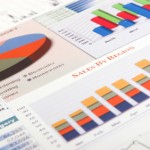When you’re a small-business owner, issues like whether you can afford to  give your assistant manager a raise or whether your dinner bread will be delivered on time loom larger than the trade deficit and crop results. Yet, the nation’s employment outlook factors into your hiring decisions and the truck that delivers your bread runs on gas — so keeping an eye on the bigger picture can help you avoid cost surprises. “If [you know] consumers are spending more in October, that might give you a bit more confidence if you’re a retailer going into the Christmas season,” says Chad Moutray, the Small Business Administration’s chief economist.
give your assistant manager a raise or whether your dinner bread will be delivered on time loom larger than the trade deficit and crop results. Yet, the nation’s employment outlook factors into your hiring decisions and the truck that delivers your bread runs on gas — so keeping an eye on the bigger picture can help you avoid cost surprises. “If [you know] consumers are spending more in October, that might give you a bit more confidence if you’re a retailer going into the Christmas season,” says Chad Moutray, the Small Business Administration’s chief economist.
While the economic recovery is still tentative — and credit remains tight — small-business owners could help themselves in 2010 by monitoring the macroeconomic picture. Already, members of the Board of Governors and the presidents of the Federal Reserve Banks, have projected that the U.S. economy will expand between 2.5% and 3.5% this year. Meanwhile, the unemployment rate is expected to fall to between 9.3% and 9.7% from November’s rate of 10%, and economists from Morgan Stanley expect that a more sustainable recovery will sink in, as the financial markets improve, risky assets continue to fetch higher prices, and bank lending improves.
In the absence of your own economist or strategic planning office, what indicators should you keep an eye on? Here are five that often matter most to small firms.
Real Personal Consumption Expenditures
Also known as consumption, this indicator, which tracks the inflation-adjusted price changes in consumer goods and services, accounts for 70% of the country’s gross domestic product — that is, the basic measure of a country’s overall output. Basically, this indicator will shed light on whether consumers are spending and how much. “When the public is hording money, small businesses are going to feel that more than anyone,” says Moutray.
Big companies can often lean on hefty credit lines to get them through rough patches, while many smaller firms don’t have the same luxury. (For the most recent consumption release, click here.)
Consumer Confidence
Similar to consumption, consumer confidence and consumer sentiment figures attempt to gauge consumer attitudes toward the economy. The more confident consumers are about the economy and their own financial pictures, the more likely they are to spend. “What we’re telling our clients is, closely follow the economic indicators, which can point to a recovery in demand trends,” says Bonnie Riggs, an analyst for the market research firm NPD Group. “When consumer confidence moves in a positive direction, they’ll see [business] traffic pick up.”
Check the Index of Consumer Sentiment, which is tabulated by the University of Michigan’s Institute for Social Research. Also, look to the Consumer Confidence Index, which is released by the Conference Board, a research firm in New York.
Producer Price Index
Businesses that make products will want to pay close attention to the Producer Price Index, which measures prices at the producer level, before they get passed on to consumers. This indicator speaks directly to how much businesses pay for their materials. When this indicator rises, most businesses will want to raise prices to keep up with higher costs. However, boosting one’s prices during a downturn may be counterproductive, as consumers are looking for savings. In this scenario, a business’s profit margins tend to get squeezed, says Moutray. By tracking the price changes within the production pipeline, however, businesses can anticipate possible inflationary pressures and make changes accordingly, he says.
U.S. Dollar
Another inflation gauge is the value of the U.S. dollar. When the greenback falls against other currencies, U.S. exports look more attractive to some foreign buyers. However, within the U.S. it may take more dollars to purchase the same materials — effectively, causing producer prices to rise.
To track whether or not this is happening, look to commodities prices. The price of gold, for example, often increases when the value of the dollar slides, says Moutray. A good resource for checking the price of gold futures is the Comex division of the New York Mercantile Exchange. Also, check how the dollar performs against a basket of trade-weighted major currencies, the U.S. Dollar Index Futures.
Unemployment Rate
Though it’s a lagging indicator, the unemployment rate, currently at 10%, can be useful for business-planning purposes, says Riggs. For example, because unemployed workers tend to skip eating breakfast out, morning sales have dampened at many restaurants. However, if the jobs picture suddenly improves, that could lead to an uptick in demand for breakfast and cause business owners to ramp up production and potentially hire more staff.
To get an even clearer sense of the labor market, however, Josh Lerner, an investment banking professor at Harvard Business School’s Arthur Rock Center for Entrepreneurship, suggests looking at the local unemployment rate. “We’re in a period where there is tremendous heterogeneity across regions of the country, and, as such, using a one-size-fits-all measure isn’t as helpful as local figures.” (For states’ rates, click here.)
Source: WSJ.com






